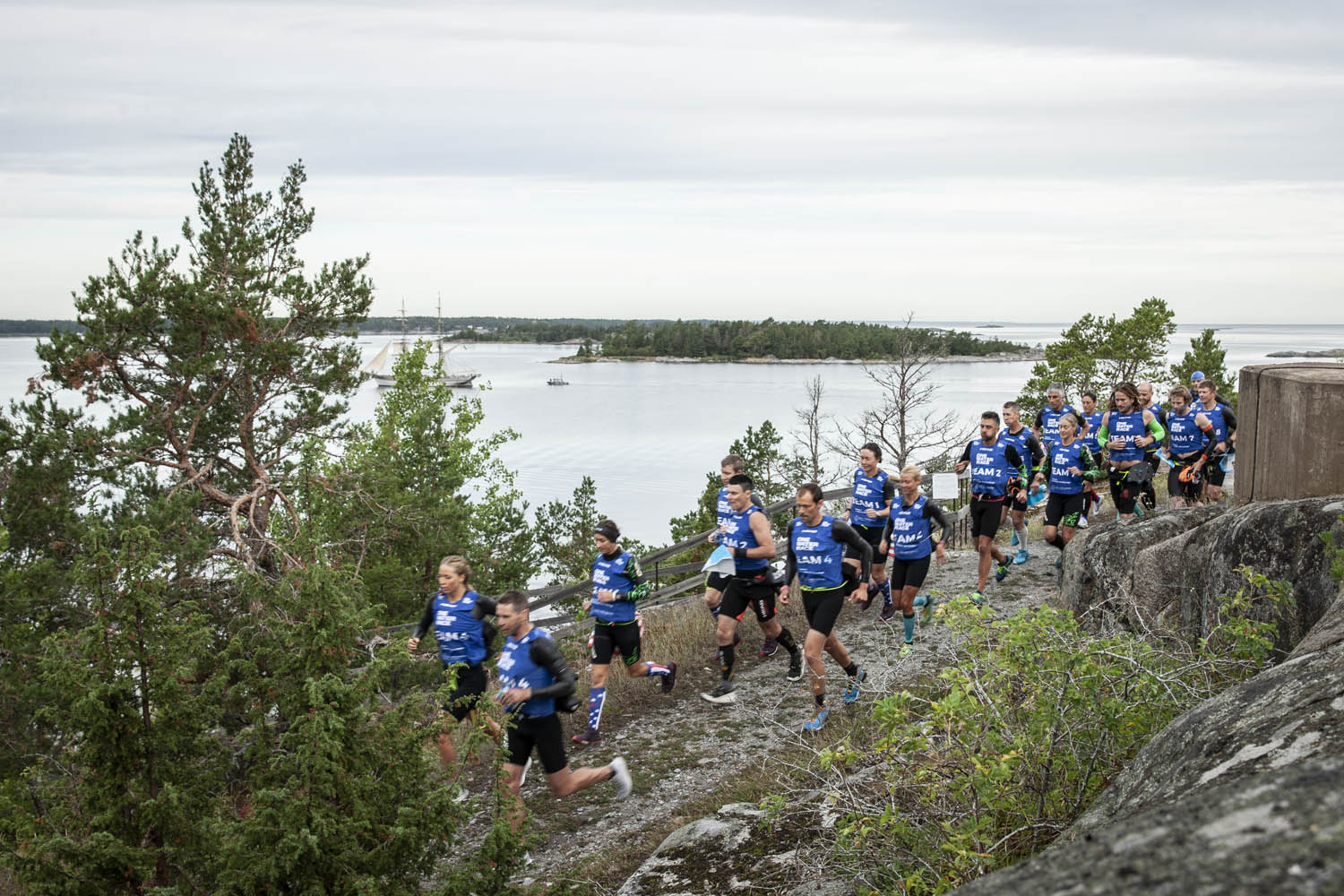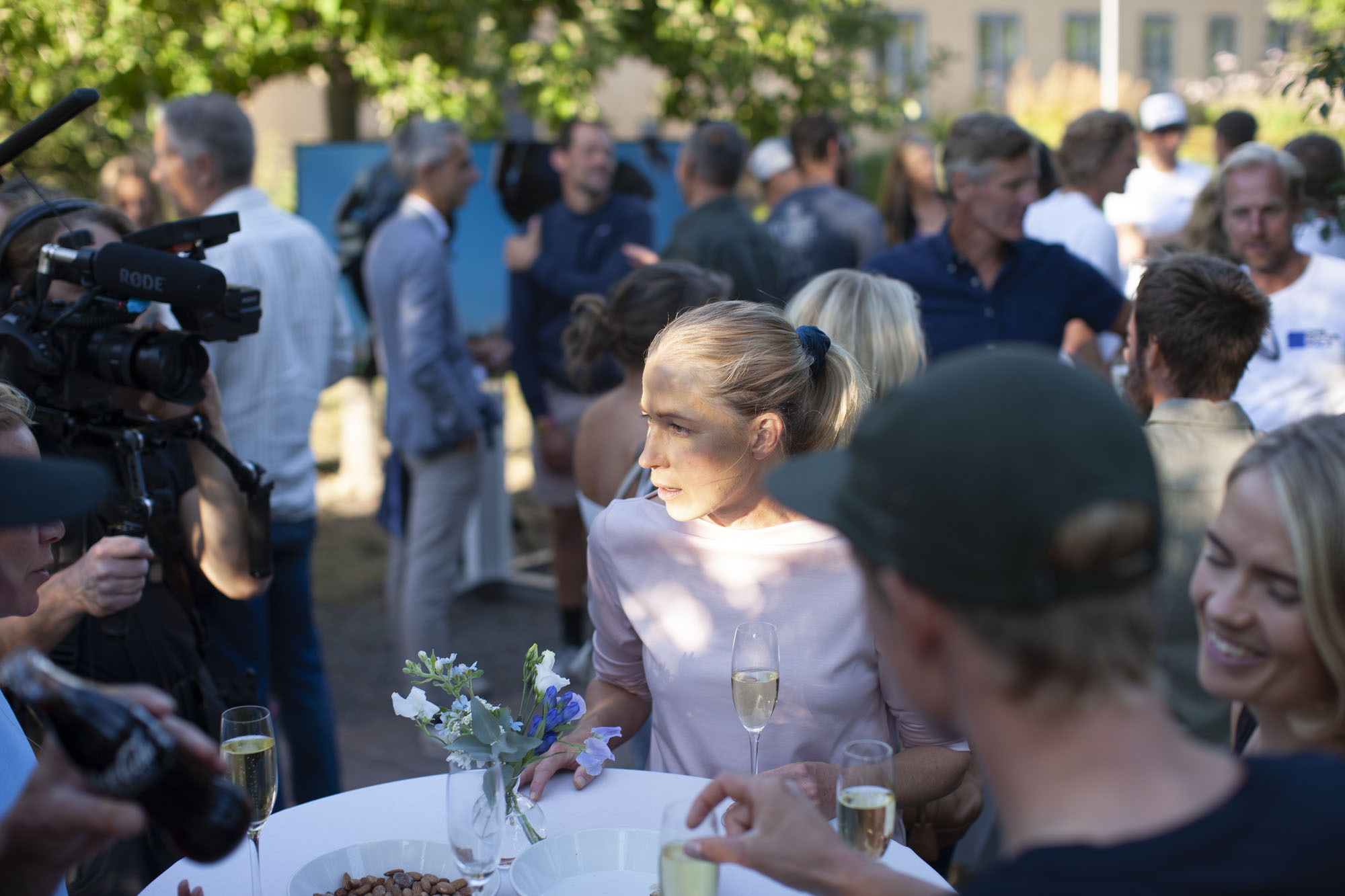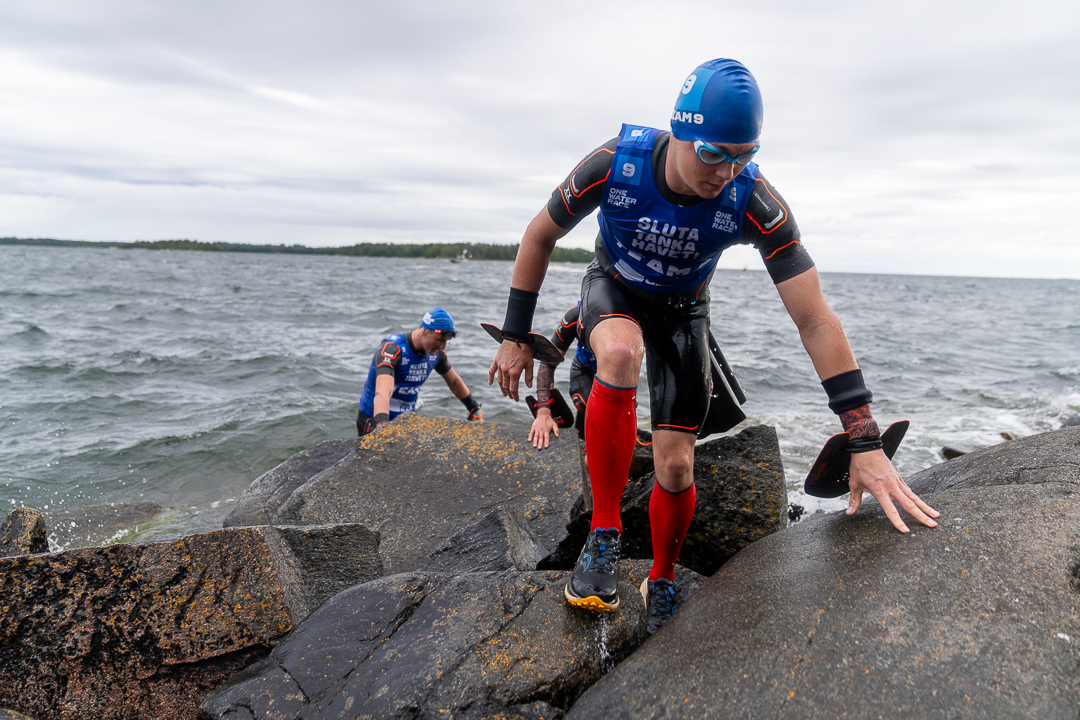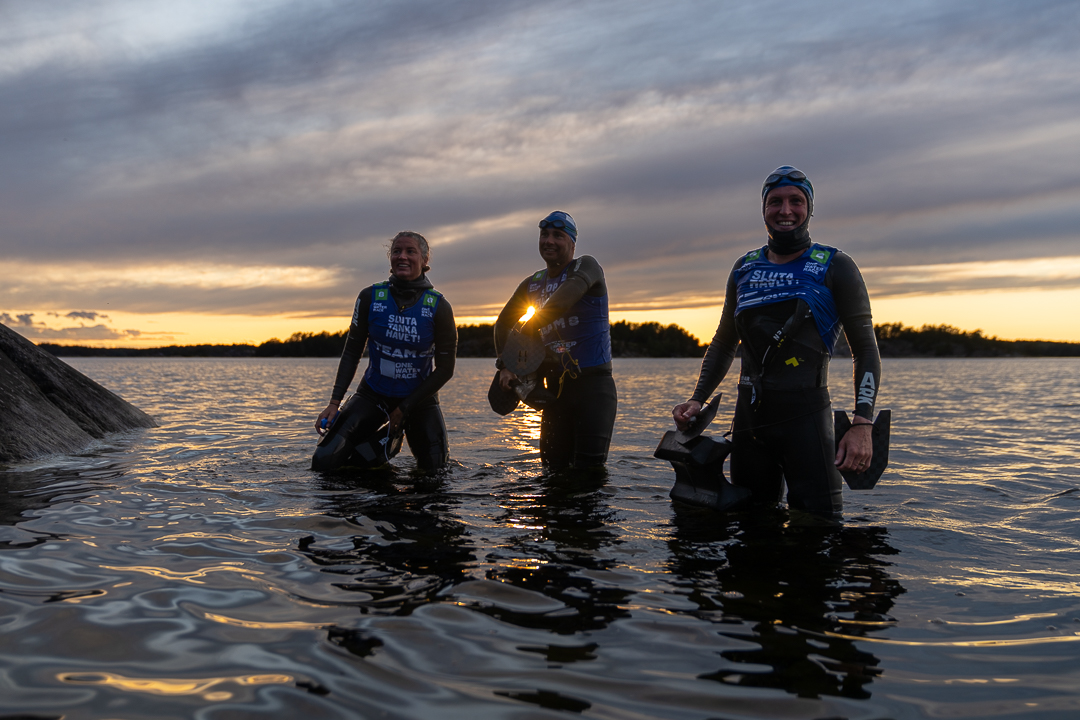These couple of days are hard to describe. This wasn’t just a race, it turned out to be so much more. It was an interaction between the organization, the teams and everyone involved on a deeper and much more important level. We shared something unique and created a community and a friendship for life.
We wanted to create the ultimate proof of human capacity, but by doing so we also created the ultimate proof of human fellowship.
ONE WATER RACE
One Water Race is based on creating a community by gathering the world’s top endurance racers towards a common goal, and where our role as an organization is about creating the absolute best possible conditions for the teams to be able to focus on the challenge ahead; the ultimate proof of human capacity.
RACE WEEK
Race Week started on Saturday. After the teams were picked up at Arlanda Airport they checked in at Nobis Hotel in central Stockholm. Many of the athletes met here for the first time, and it quickly became obvious that most of them knew each other from before, from previous races but also from the film portraits we produced during the spring and the summer.
Sunday morning began with the teams packing their personal racing equipment for onward transport to Arholma. The teams then walked together through a sunny and beautiful Stockholm to Hotel Skeppsholmen where the official opening of One Water Race 2022 was held.

Meeting the teams for the first time was very special and also a little bit surreal. They were all selected and went through an application process. Our media crew visited them in their home countries, where they told us their stories and their thoughts and ideas about the race. We had a lot of contact along the way but never met in person so it was very emotional and absolutely wonderful to finally meet each other and officially open One Water Race 2022.
Afterwards, a ferry arrived to take the teams all the way up to Arholma and our Race Camp before the start on Tuesday. For many of the athletes it was the first encounter with the Stockholm archipelago, and the challenge suddenly became very real as the boat was filled with excitement and anticipation.
Arholma Nord is a beautiful and quietly located guest house at the absolute northern tip of the Stockholm archipelago. We had the entire guest house for ourselves so that the teams could have peace and quiet during their race preparations. On arrival, our host Robin and his staff welcomed everyone on the jetty and many of the teams immediately geared up and tested the waters and the temperature. I took a dip myself and it was a bit colder than I thought. I could tell that the low temperature would really be a decisive factor during the upcoming race.
Sunday afternoon came and it was time for the final Race Briefing and not least some traditional “Swedish fika” (coffee and home-baked buns). A highly important part of Swedish culture and therefore felt appropriate to have it in the race preparations and throughout the race week.
One Water Race is all about how to create the “ultimate proof of human capacity”, and how to prepare and train the body to move forward with its own power; running and swimming for very long times and distances. Furthermore, the mental aspect required in handling this challenge is a crucial component in successfully experiencing this competition. And finally, how to read and manage the terrain to find the best and fastest way forward; bringing forward the important of navigating, orienteering and taking quick and smart decisions throughout the race.
As an organization we wanted to create the absolute best conditions for the selected teams to cope with this challenge both during their preparations and during the race. The most important tool we could give the teams is accurate maps, and therefore we decided to produce our own race maps. Our map producer, Stefan Kinell, is a map expert and a very experienced orienteer. The teams met Stefan digitally before the race and had since the spring had access to the digital maps. Now they finally got to meet Stefan in person for a final briefing and not least get a first printed map to read on.
Sunday evening came and a wonderful barbecue awaited at sunset. The teams now had the evening and all of Monday to enter into their race bubble, enjoy the moment and await the adventure ahead.
MONDAY AUGUST 22nd
One Water Race is both an organizational and logistical challenge. The organization consist of approx. 90 persons where everyone is a specialist in their field and who complement each other exceptionally well. The race course extends over the entire archipelago, having four Race Camps located along the course along with sixteen boats and ships being deployed to guarantee complete safety for the racers as well as to support the logistics, around the clock over three days.

Preparations had been in the making for a long time and on Monday the organization met on Arholma for a final briefing, inspecting the boats, materials, communications, technical equipment, medical care and fine-tuned all the details. These elements comprise the very heart and brain of One Water Race and together we tried to gather the absolute best, but not also the most warmhearted persons to form the nucleus of the competition. Just like with the teams, we wanted to create a dream team that has what it takes to both accept and manage this incredible challenge.
It was also now that the teams gained access to their safety boat and met their skippers and ultrarunners for the first time, two essential roles for both safety and communication.
The safety boat follows the team all the way, around the clock. Each boat has a skipper who works in 8-hour shifts and has the ultimate responsibility for the safety of the teams during the swims, and who handles all communication between the team’s Support Crew and race management during the race. On top of that, the ultra-runner is a safety resource that follows the teams on land and rests on the safety boat during the swims. The ultrarunner is equipped with a camera and films the teams around the clock. All to create complete coverage to be able to report and document all moments, events and experiences during the race.
During Monday you could really feel the excitement in the air. We had all been preparing for so long and now there were only a few hours left until the start, and the calm. The calm when the race would finally be underway and there was nothing left to do but do your best and enjoy the experience.
TUESDAY AUGUST 23rd – RACE START
04:00 and finally Race Day! Out of the pitch-black darkness, a clear blue sky and a sunrise loomed incredibly beautifully, giving us a fantastic start to the race. Everything was already packed and ready, so now it was mostly about having breakfast in peace, drinking a morning coffee, and going through the final details. Even though we were all facing this enormous challenge, there was an upbeat atmosphere, and I think everyone actually felt a sense of relief that the time was almost here. Time to start, time to race.

At 06:15 we gathered the teams down by the water for the first part of the starting process, distribution of the first maps. Stage Norrtälje, now marked with check points.
For me it was truly a solemn moment, to finally hand out the maps and see the teams run off to set their first plan and make their route choices down towards Landsort.
Navigation and orienteering are the foundations of the One Water Race. There is no course, only an unknown number of check points that must be passed on the way down to Landsort. The route is divided into five stages, and the teams only get one map and one Stage at a time; this so that the teams will not be able to plan the entire route in advance, but it is also about being able to manage navigation and orienteering under sleep deprivation, exhaustion, and very stressful conditions for several days.
The time came and the teams had 30 minutes to set the strategy for Stage Norrtälje covering approximately 25 islands, 50 km running and 15 km swimming. The teams spread out to prepare the course, and in the meantime the boats were made ready for the start, skippers, ultra-runners, and the whole organization were made ready to finally start the race.
At 06:45 we all went up to the start line together, overlooking the mile-long view of the
Stockholm archipelago, which had now been gilded with the presence of Briggen Tre Kronor, our beautiful Race HQ. The Governor of Stockholm wished the teams good luck, and off went the start.
THE RACE
I have had so many different thoughts about the different teams’ strategies, both in terms of route choice, pace, energy intake and rest. When it came to pace, I thought that perhaps one team would start at a high pace to try and split from the group from the start. The reality was different, with all teams adopting a fairly calm and common pace.
STAGE NORRTÄLJE
A long section with both long swims and long runs covering approximately 23 islands, 47 km run and 11 km swim.
It was interesting right from the start with a couple of route choices that I hadn’t anticipated and an interesting spread already early in the race down to Check Point 1. Perhaps what stood out the most was that Team 3 USA chose to start with a long swim of just over 3 km and who kept a good and even pace with Team 1 USA. Otherwise, we could see that Team 4 Sweden/Australia kept good speed, took the lead, and it held throughout Stage Norrtälje.
Early in the Stage something very strange happened; Justin Smith/Team 7 USA got stuck in an electric cow fence and couldn’t get out. The shoe was stuck and when he tried to free himself, he received electrical shocks. I don’t know how he managed, but there are wonderful videos of him trying to master the fence and the electricity. Unfortunately, not the best start of the race, but the total joy of Team 7 USA was fantastic to watch during the race.
RACE LOGISTICS
At the end of Stage Norrtälje, it was time for our first skipper rotation. Having safety as our number one priority, the skipper holds a big responsibility during their 6–8-hour shifts. Our logistics organization shuttled rested skippers to our meeting point while those who had just been out went to back to one of our Race Camps to rest, eat and sleep.
The ultra-runners favored longer rotations, some opting for 36 hours, therefore many were out for a very long time to be able to follow the teams’ challenges along the way.
Our Race HQ is located onboard Briggen Tre Kronor, which follows the race from Arholma to Landsort, this is where our race management, our communication dispatch, the medic team, and the media production were located. We followed the teams via three different GPS systems, communicate with skippers and ultrarunners and follow each team and each participant the whole way, every step, and every swim. We tracked their route choices, race strategy and pace to make sure that always stayed one step ahead in terms of logistics and planning.
STAGE 2 ÖSTERÅKER
Being the shortest stage of the race yet one of the most challenging with many long swims and short runs covering about 20 islands, 22 km run and 10 km swim.
It was still early in the race but there was a bit of a chill in the air and the cold definitely becoming a factor in the team’s progress. The first challenge here was a stretch with many long swims and small islands where it proved hard to get warm during the runs.

It was here where we would experience the first rivalry between the teams, Team 8 Australia closely followed by Team 2 Sweden. Some thought it was a bit too tight, others thought it was a tactical choice and you could really sense the real competition and even irritation in the air. These two teams and their rivalry would follow for much of the race.
STAGE 3 VÄRMDÖ
The longest Stage of the race, with very challenging terrain and swims in the outermost part of the archipelago covering approximately 60 islands, 65 km run and 16 km swim.
Soon came the night with pitch-black darkness, the absolute most difficult terrain and very advanced orienteering which inevitably slows down the speed considerably and where race positions can easily and quickly change. Team 4 Sweden/Australia had a lead of almost 40 minutes but chose a safer and longer route to Check Point 7, while Team 8 Australia, with Team 2 Sweden in tow, pushed straight on and completely crushed the terrain. Now the top teams were gathered, and at the same time we had an even fight for fourth place between Team 1 USA, Team 3 USA and Team 5 South America. The race was more alive than ever.
Stage Värmdö is incredibly long which witnessed many transitions of light and temperatures. A period of the race where the teams passed both 24 and 36 hours and where lack of sleep, exhaustion and cold really started taking their toll. In the final part of the stage the teams spent a long time in the outer, most exposed part of the archipelago, becoming increasingly chilled when arriving at Check Point 9 and the transition to Stage Haninge. The course continued with a couple of long and challenging swims before getting to longer runs, a challenge that proved too difficult for two of the teams. Team 1 USA were considerably frozen and chose to throw in the towel, while Team 7 USA unfortunately did not make the Cut Off time in order to keep competing.
STAGE 4 HANINGE
A Stage that begins with a challenging swim and later offers a lot of running covering approximately 30 islands, 45 km of running and 8 km of swimming.
Team 4 Sweden/Australia had once again taken the lead, and Team 8 Australia had pulled away from Team 2 Sweden in the lead. Further behind Team 3 USA and Team 5 South America fought for fourth place and not least to reach Check Point 12 in time to make the Cut Off before the last stretch to Landsort.
At this time, it also became clear that the fight for positions more and more shifted into managing the challenge. It was about survival and being able to finish the race.
Team 2 Sweden dropped to second place but fought on a much slower pace, Team 3 USA had long considerations about continuing and finally decided to finish at Check Point 11, and Team 5 South America fought against the clock but unfortunately did not make it to the Cut Off at Check Point 12. There were now only 3 teams left in the race.
STAGE 5 NYNÄSHAMN
The final stage starts with a 6.5 km swim across the open sea and the infamous “Danziger Gatt”, and on to cover approximately 15 islands, 22 km run and 9 km swim.
The racers reached a critical level both in the fight against seasickness, lack of sleep and not least lack of energy; where the body forms a reserve fuel due to lack of glucose, a state called ketosis and where the body secretes a strong smell of acetone. In this state it is difficult to manage the navigation ability and it is hard when the race enters the final phase to have the ultimate ability to deal with these kinds of physiological challenges and limitations.
This is where I thought I would first see limitations with the top teams, but they showed no limitation whatsoever, there was just an incredibly impressive handling of the situation and a camaraderie that was so beautiful and very emotional. There was only one goal, the lighthouse at Landsort and no obstacles in their way would hinder them from reaching it.
THE FINISH

The night had turned into dawn, and we were met by an incredibly beautiful sunrise at Landsort, and the first team only had a couple of islands to go before finally arriving at the island of Öja and the last run up to the lighthouse of Landsort.
It was an unreal feeling. A distance, and a challenge that many thought was impossible, was now about to be mastered. I had been realistic, I had expected at least half of the teams to break, and I had set an ideal time of around 60 hours but thought a winning time of 55 hours was possible. Now we not only knew that it was possible, but that the winning time would be around 47 hours. An astonishing performance to say the least.
It was 05:45 on Thursday morning, I was standing at the Landsort lighthouse, looking out over the Baltic Sea, waiting for the winning team in the first edition of One Water Race. I saw Kristin, Daniel, Adriel and Johan coming up the last hill towards the lighthouse and the tears came crashing. A dream had come true and the beginning of something that had become so much more than just a race was coming into fruition.
At 06:19, Team 4 Sweden/Australia placed their hands on the door to the Lighthouse of Landsort as the winners of the first One Water Race. The immense sense of satisfaction and happiness was of course felt throughout the team and came out in force later, but it was the relief of reaching the finish line was the dominating emotion on show. Team 8 Australia really pushed on all the way and at 08:52 they placed their hands on the lighthouse’s door as the second finishing team. Team 2 Sweden took a couple of hours of sleep to make it through the last stretch and at 17:38 they put their hands on the gate as the third and last team to make it all the way to lighthouse of Landsort. Each team and each participant proved that together the human power can be infinitely challenged.
Thank you, Sarah, Misty, Kristen, Jarrod, Johanna, Martin, Richard, Jonas, Chris, Jason, Renee, Timothy, Adriel, Daniel, Johan, Kristin, Brett, Justin, Lara, Melissa, Elizabeth, Glenn, Julian, and Rob.
AFTER RACE

Thursday evening came and all the teams were gathered at the Nobis Hotel again, where a large, soft, and well-made hotel bed was awaiting. During Friday there was time for recovery and some media activities before the final evening together. A banquet and award ceremony was enjoyed at Hotel Skeppsholmen with all teams, relatives and not least the entire One Water Race organization being present. It was a time to celebrate and enjoy what we all together had been part of. We had all contributed and shared an amazing experience that we would all take with us for the rest of our lives.
END
I don’t know what I had expected but the One Water Race became an interaction between the teams, skippers, ultrarunners and the organization, on a much deeper and more human dimension than what I or any of us had anticipated. We shared a life experience and made lifelong friendships. So much more than just a race.
Our initial goal was to create a race which would challenge and promote the ultimate proof of human capacity, and by doing so we also created and witnessed the ultimate proof of human fellowship and comradery A beautiful harmony of two creations coming together.
/Thomas



